The first breath spectrograms show external, single and и simultaneous exposure of the child throughout the energy spectrum with concurrent activation of radionuclides and emergence of the new ones, which are not peculiar to mother. The entire process occurs in the time interval of 60 seconds to 300 seconds.
The amount of statistical data allows to make a conclusion based on the binary algorithm, namely, in the process of delivery, as of the moment of the first breath of a child, emergence of electromagnetic wave is recorded in the gamma quantum spectrum. Supposedly, the source of the wave is a child.
1 – Introduction;
2 – Equipment;
3 – Results.
The authors express their gratitude to Chief Physician of A.A. Abrikosova Municipal Maternity Home No. 6 Braginskaya S.G., obstetric officers Arutyunyants A.G. and Blokhina T.V., pediatrician Alova S.V. for the possibility to make observations and measurements, support in work and professional consulting, and to all the staff of A.A. Abrikosova Municipal Maternity Home No. 6 for every possible assistance in the research.
The authors are grateful to Chief Physician of the International Women Center Kusnetsova T.V. for the afforded opportunity to observe women of various gestational age and fir the professional consulting.
Figure No. 1. Interactive event diagram (by gamma), excluding external background.
Figure No. 2. Diagram of events at count rate in gamma pulse per second (count rate 500 pulse/sec).
Table No.1. Average activity of radionuclides by gamma radiation, as of the moment of delivery, the first breath and postnatal supervision.
The spectrogram No. 1 – mother before delivery.
The spectrogram No. 2 – mother after delivery.
The spectrogram No. 3 – the first breath of a child.
The spectrogram No. 4 – early postnatal supervision.
- 1 -
The biophysical studies carried out in 2009 – 2011 in the medical physics sector provided researchers with interesting information.
A correlation between human physiology and activity of the radionuclides distributed in human body was revealed. Statistically-valid energy redistribution in human body was recorded within a circadian cycle that was observed in the form of changing activity of radionuclides depending on time of day.
The radiometric and spectrometric methods applied in the research allowed for the conclusion that a human is a source of an electromagnetic wave in the gamma quantum spectrum. Intensiveness of human radiation in the gamma spectrum varies depending on time of day and reduces with ageing.
An electromagnetic wave in the gamma quantum spectrum is identical to a photon flux, or to a flow of light, in other words. We can say that a human is radiant, and the luminous intensity changes depending on time of a day and steadily reduces with ageing.
There arose a logical question, when exactly a human acquires the ability to be a source of an electromagnetic wave in the gamma radiation spectrum. In order to answer the question observations and test spectrometric measurements were conducted in the period of pregnancy and at the moment of delivery.
The research was performed in the facilities of Municipal Maternity Home and Women Center for Pregnancy Support.
Participants in the radiometry sector numbered 18. Those in the spectrometry numbered 12. The total number of experimental subjects was 30 people. The measurements were made against human body, with end face of the detector. The margin of distance error was ± 0.5 cm.
- 2 -
Equipment: Canberra InSpector 1000 – digital scintillation gamma-spectrometer, software Genie – 2000, stabilized scintillation gamma radiation detector unit with a NaI(TI) crystal. IPROS – 2.
Measured energy range was 50 keV – 3 MeV. Energy resolution in the peak of total absorption of gamma quanta with energy 661.6 keV was up to 8 %. External detection unit response to the gamma radiation of nuclide Cs – 137 – 1300 ranged ± 46 pulse/seс/µSv/h.
Spectrum length – 256, 512, 1024, 2048 or 4096 channels.
Integral nonlinearity – no more than 0.6 %.
Spectrometric tract capacity – no less than 5 х 104 pulse/sec.
Maximal input count rate – no less than 5 х 105 pulse/sec.
Verification certificate No. 3 – 22589/13311104 (Federal State Institution, Mendeleev Center for Standardization, Metrology and Certification).
Equipment: Radiation dosimeter ИРД -02.
Specifications:
Photon radiation dose rate measurement range, µSv/h: 0.10 – 100.
Photon energy range in dose rate measurement, MeV: 0.04 – 3.0.
Verification certificate 41054. No. 1К964, Federal State Unitary Enterprise (FSUE) National Research Institute for Physicotechnical and Radio Engineering Measurements.
Measurements of the control source.
In gamma mode – (1.7 ± 0.1) µSv/h.
- 3 -
Average data obtained from the research.
Due to the sanitary norms and behavior ethics, it was impossible to arrange a low-background protection or to install a collimator in the delivery room. In order to obtain statistically-valid data the following values were introduced and calibrated:
Е1 –
mother’s specific activity before delivery (µSv/h), (gamma pulse/sec);
Е2 – child’s specific activity – the firth breath (µSv/h), (gamma pulse/sec);
Е3 - measurement range child’s specific activity in postnatal supervision (µSv/h), (gamma pulse/sec);
Е4 – mother’s specific activity after delivery (µSv/h), (gamma pulse/sec);
Measurement data (by gamma):
Е1 – 0.079
(µSv/h); 300 gamma pulse/sec (count rate 500 pulse/sec).
Е2 – 0.1 (µSv/h); 320 gamma pulse/sec (count rate 500 pulse/sec).
Е3 – 0.093 (µSv/h); 318 gamma pulse/sec (count rate 500 pulse/sec).
Е4 – 0.084 (µSv/h); 312 gamma pulse/sec (count rate 500 pulse/sec).
Calibration values:
Room background was 0.075 µSv/h. 304 gamma pulse/sec (count rate 500 pulse/sec).
Induced interference from the obstetrical team was 0.07 µSv/h.
Horizontal axis is time.
Vertical axis is µSv/h.
Before the moment of delivery specific activity of mother and child coincide, therefore, there is a layover effect on the diagram.
The interference from the obstetrical team 0.07 µSv/h – were not reflected on the diagram to avoid overloading of the picture.
Figure No. 1. Interactive event diagram (by gamma), excluding external background.
Calibration values:
Green line – room background.
Measured values:
Blue color – mother.
Red color – child.
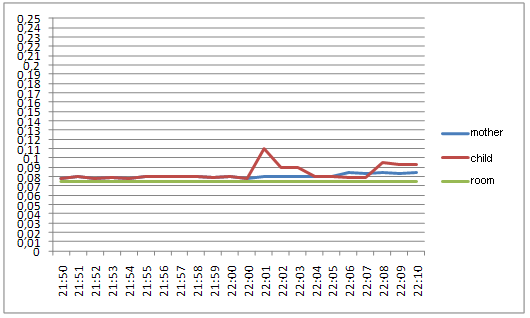
Contractions First breath. Supervision.
Figure No. 2. Diagram of events at count rate in gamma pulse per second (count rate 500 pulse/sec).
Vertical axis – count rate, gamma pulse per second.
Horizontal axis – events.
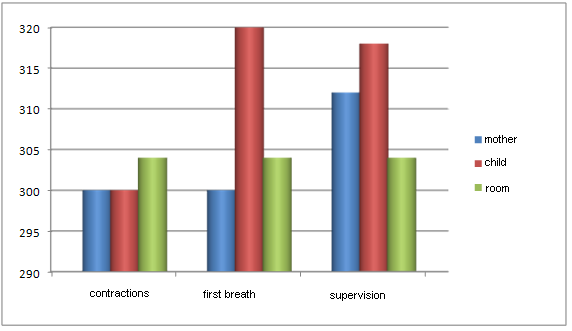
Analysis of the spectrograms does not allow to make a conclusion about presence of peaks or enlargement of the peak area at the moment of the first breath. The spectrogram of child’s first breath differs from mother’s spectrogram only by less number of events throughout the energy spectrum. At the same time, increase is observed in gamma pulse per second count rate, as well as increasing dose value upon radiometric control.
In the first face, this inconsistent fact is explained by activity of natural radionuclides formed in the period of fetus development, which manifested their activity as late as at the moment of child’s firth breath. In theory and in practice of the issue, activity of the radionuclides should have been manifested in mother in the period of pregnancy. However, no statistically valid data for any changes in photon radiation of a pregnant woman was found. The observable terms of pregnancy were 12 to 39 weeks. Additionally, recorded and measured activity of radionuclides is observed at the moment of child’s first birth, which was not peculiar for mother during contractions.
In the observation performed, the aggregate activity of radionuclides was manifested in the form of increase in gamma pulse per second count rate and growth of dose value upon radiometric control.
Average activity of radionuclides by gamma radiation as of the moment of delivery, the first breath and postnatal supervision. Control measurement – mother’s spectrogram as of the moment of the first contractions and 3 to 5 minutes before the delivery.
The analysis was conducted by the method of peak search by nuclide correlation (excluding external background) and by the method of minimal detector activity (MDA), activity of 214Pb was measured. Libraries used: “ANSI Gamma Guru. NLB”, “STD Lib”, “NLB”.
Table No.1. Average activity of radionuclides by gamma radiation, as of the moment of delivery, the first breath and postnatal supervision.
| Nuclide |
Mother before delivery (µCi) |
Mother after delivery (µCi) |
The first breath (µCi) |
Early postnatal supervision of the child (2 – 5 min. after delivery). (µCi) |
Later postnatal supervision of the child (25 – 30 min. after delivery). (µCi) |
| 235U |
4.102 × 10-2 |
2.023 × 10-2 |
2.618 × 10-2 |
4.180 × 10-2 |
2.301 × 10-2 |
| 40K |
4.312 × 10-1 |
1.135 |
1.204 |
1.948 |
3.607 × 10-1 |
| 238U |
5.808 × 10-1 |
9.011 × 10-1 |
8.000 × 10-1 |
5.100 × 10-1 |
3.204 × 10-1 |
| 214Pb |
1.808 |
1.888 |
2.001 |
1.920 |
1.834 |
| 214Bi |
2.475 × 10-1 |
7.407 × 10-1 |
1.54 × 10-1 |
1.513× 10-1 |
5.367 × 10-1 |
| 238U + dau |
3.993 × 10-1 |
4.823 × 10-1 |
4.968 × 10-1 |
2.010 × 10-1 |
3.192 × 10-1 |
| 231Ра |
no |
no |
1.423 × 10-1 |
no |
no |
| 7Be |
no |
no |
1.006 × 10-1 |
5.300 × 10-2 |
no |
| 22Na |
no |
no |
9.449 × 10-4 |
no |
no |
| Pu |
no |
no |
4.192 × 10-2 |
4.290 × 10-2 |
no |
22Na – activity is specified as non-stable.
Observations: the children who have no transuranian elements according to spectrogram analysis as of the moment of the first breath are subject to respiratory failure during early postnatal supervision and intensive care. Prognostic on Apgar scale reduces in the absence of the following radionuclides: 231Ра, 7Be, Pu at the first breath.
The identified radionuclides belong to natural radionuclides and have low activity. In 99.99% of cases the activity is below 1 µCi, thus enabling to classify the radionuclides as posing low danger to human health.
Spectrograms.
Y-axis is event count.
X-axis is energy (keV)
No. 1 – mother before delivery.
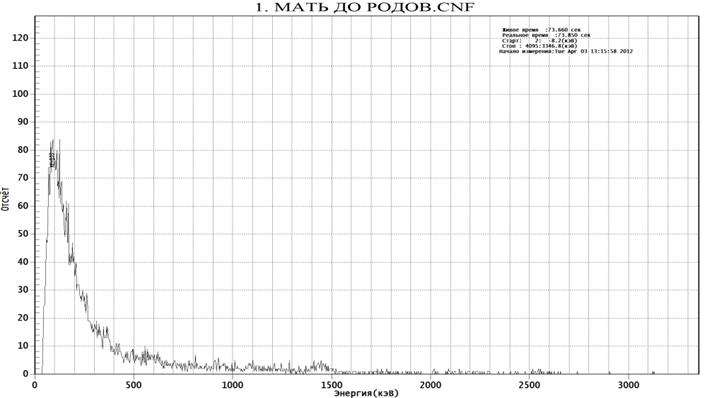
No. 2 – mother after delivery.
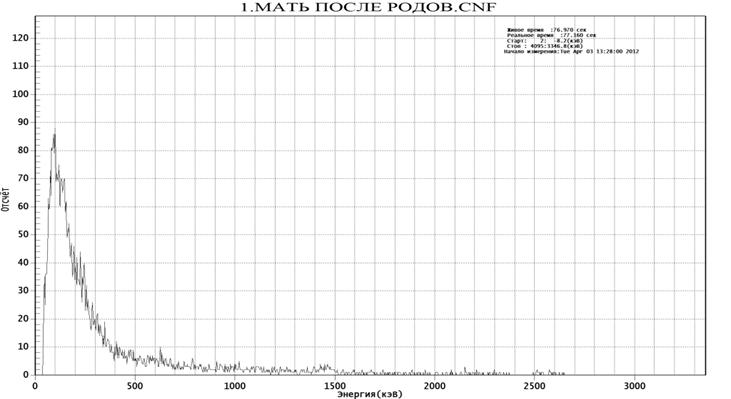
No. 3 – the first breath of a child.
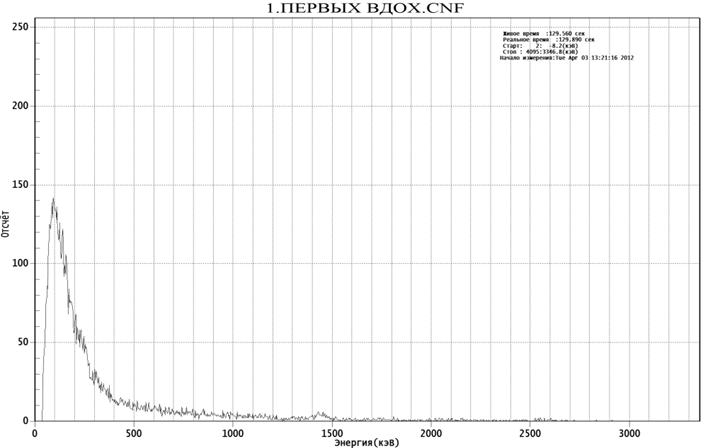
No. 4 – early postnatal supervision.
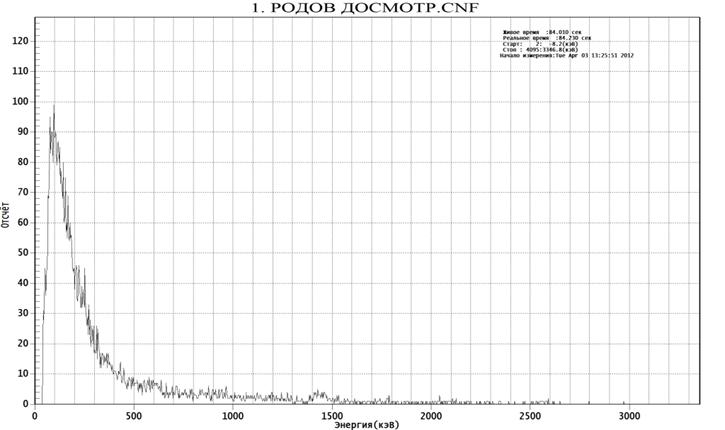
Analysis of the spectrograms and activity of the radionuclides allows for a conclusion that there is no energy redistribution or energy transfer from mother to child.
The first breath spectrograms show external, single and и simultaneous exposure of the child throughout the energy spectrum with concurrent activation of radionuclides and emergence of the new ones, which are not peculiar to mother. The entire process occurs in the time interval of 60 seconds to 300 seconds.
The fact of emergence of new natural and cosmogenic radionuclides as of the moment of the first breath and disappearance of the same within 5 to 20 minutes doubt accuracy of the experiment. On the other hand, the steadiness of emergence of new natural and cosmogenic radionuclides and quick disappearance of the same suggest that we are facing an unexplored phenomenon.
The amount of statistical data allows to make a conclusion based on the binary algorithm, namely, in the process of delivery, as of the moment of the first breath of a child, emergence of electromagnetic wave is recorded in the gamma quantum spectrum. Supposedly, the source of the wave is a child.

 View this article in Russian
View this article in Russian